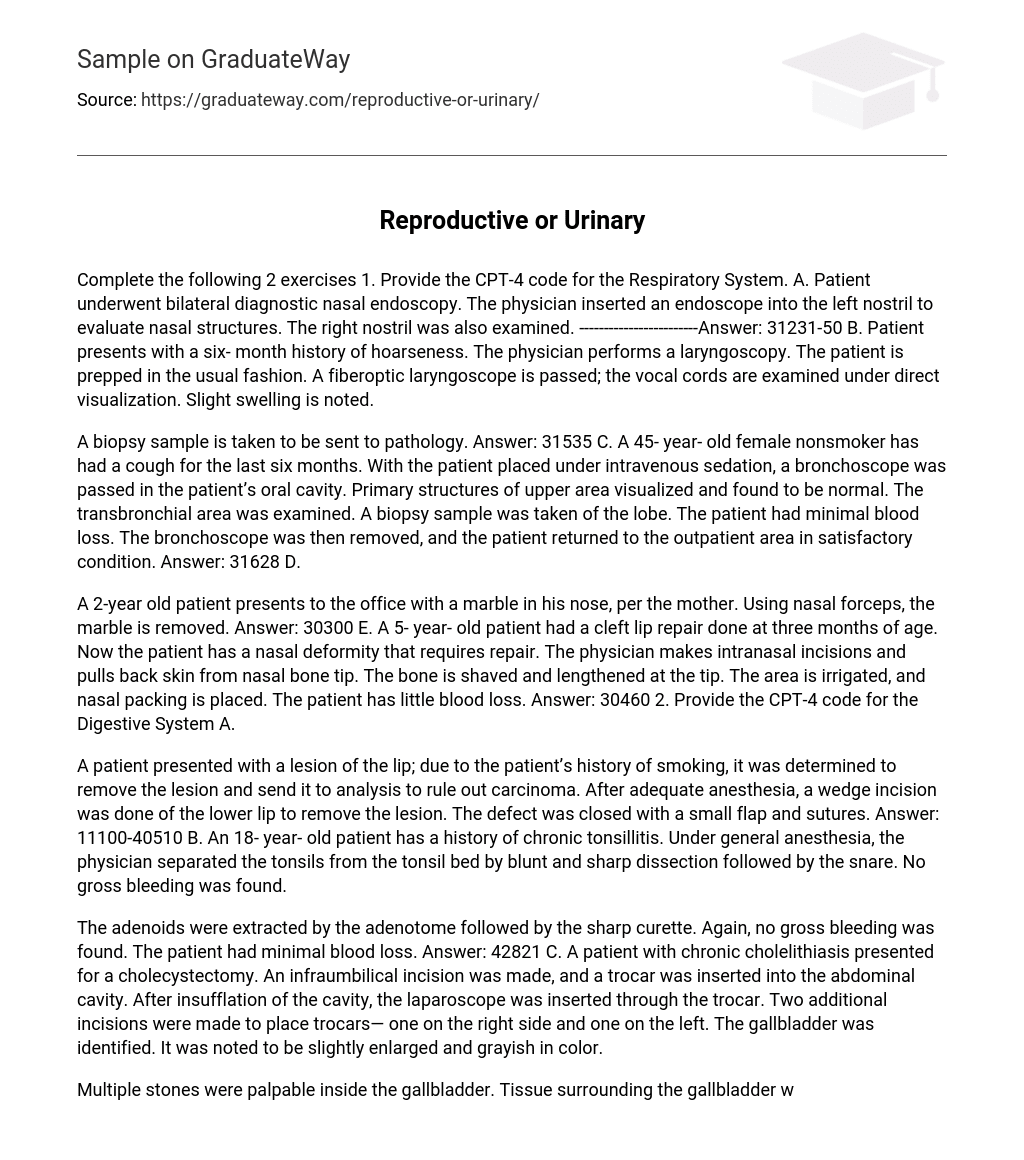- Patient underwent bilateral diagnostic nasal endoscopy. The physician inserted an endoscope into the left nostril to evaluate nasal structures. The right nostril was also examined.
- Patient presents with a six- month history of hoarseness. The physician performs a laryngoscopy. The patient is prepped in the usual fashion. A fiberoptic laryngoscope is passed; the vocal cords are examined under direct visualization. Slight swelling is noted. A biopsy sample is taken to be sent to pathology.
- A 45- year- old female nonsmoker has had a cough for the last six months. With the patient placed under intravenous sedation, a bronchoscope was passed in the patient’s oral cavity. Primary structures of upper area visualized and found to be normal. The transbronchial area was examined. A biopsy sample was taken of the lobe. The patient had minimal blood loss. The bronchoscope was then removed, and the patient returned to the outpatient area in satisfactory condition.
- A 5- year- old patient had a cleft lip repair done at three months of age. Now the patient has a nasal deformity that requires repair. The physician makes intranasal incisions and pulls back skin from nasal bone tip. The bone is shaved and lengthened at the tip. The area is irrigated, and nasal packing is placed. The patient has little blood loss.
- A patient presented with a lesion of the lip; due to the patient’s history of smoking, it was determined to remove the lesion and send it to analysis to rule out carcinoma. After adequate anesthesia, a wedge incision was done of the lower lip to remove the lesion. The defect was closed with a small flap and sutures.
- An 18- year- old patient has a history of chronic tonsillitis. Under general anesthesia, the physician separated the tonsils from the tonsil bed by blunt and sharp dissection followed by the snare. No gross bleeding was found. The adenoids were extracted by the adenotome followed by the sharp curette. Again, no gross bleeding was found. The patient had minimal blood loss.
- A patient with chronic cholelithiasis presented for a cholecystectomy. An infraumbilical incision was made, and a trocar was inserted into the abdominal cavity. After insufflation of the cavity, the laparoscope was inserted through the trocar. Two additional incisions were made to place trocars— one on the right side and one on the left. The gallbladder was identified. It was noted to be slightly enlarged and grayish in color. Multiple stones were palpable inside the gallbladder. Tissue surrounding the gallbladder was dissected. The cystic duct and artery were clipped and then cut. The gallbladder was dissected from the liver bed and removed through the umbilical trocar site. Careful irrigation of the cavity was done. The patient had minimal blood loss.
- A 19 year old patient presented to the hospital with a history of bloody stools of three weeks duration. The patient was prepped for a sigmoidoscopy. The sigmoidoscope was passed without difficulty to about 40 cm. The entire mucosal lining was erythematosus. There was no friability of the overlying mucosa and no bleeding noted anywhere. No pseduopolyps were noted. Biopsies were taken at about 30 cm; these were thought to be representative of the mucosa in general. The scope was retracted; no other abnormalities were seen.
- A patient with a history of breast cancer presented for a biopsy of her liver to confirm metastasic disease. The abdomen was exposed by an incision through the skin, fascia, and muscle. A wedge-shaped section of the liver was resected. This specimen was sent to pathology.
Reproductive or Urinary
The patient underwent various diagnostic procedures for different medical issues. The first patient had bilateral diagnostic nasal endoscopy and laryngoscopy due to a six-month history of hoarseness. A biopsy sample was taken to be sent to pathology. The second patient had a bronchoscopy due to a persistent cough that had lasted six months. A biopsy sample was taken from the transbronchial area. The third patient had a nasal deformity that required repair. The physician made intranasal incisions, shaved and lengthened the nasal bone tip, irrigated the area, and placed nasal packing. The fourth patient had a lesion of the lip removed and sent to analysis to rule out carcinoma due to a history of smoking. The fifth patient underwent a tonsillectomy and adenoidectomy due to chronic tonsillitis. The sixth patient underwent a cholecystectomy due to chronic cholelithiasis. A wedge-shaped section of the liver was resected from the seventh patient to confirm metastatic disease from breast cancer.
Cite this page
Reproductive or Urinary. (2016, Sep 27). Retrieved from
https://graduateway.com/reproductive-or-urinary/





